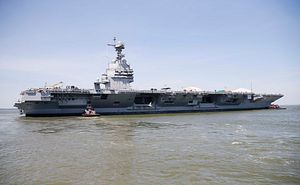The U.S. Navy’s long-delayed nuclear-powered Gerald R. Ford-class aircraft carrier USS Gerald R. Ford (CVN-78) will take to the sea for builder’s trials this week, the commander of U.S. Naval Systems Command, Vice Admiral Tom Moore, said on April 3, according to USNI News.
The carrier is slated to depart Huntington Ingalls Industries shipyard in Newport News, Virginia tomorrow, weather permitting. The USS Gerald R. Ford remains moored pier-side as of today. The crew of the new supercarrier has recently completed extensive pier-side tests in which the sailors aboard the ship simulate operating the vessel as if it were at sea.
According to Breaking Defense, Moore expressed optimism at this year’s Sea-Air-Space conference that the lead ship of the new Ford-class of aircraft carriers will be commissioned in 2017: “I think we’ll get the ship delivered in the April-May time frame and then we can move on with commissioning.”
This timetable corresponds with a January 12 U.S. Navy statement, which foresees builder’s sea trials in March 2017, acceptance trials in April 2017, and delivery in April 2017 pending the results of sea trials. “Gerald R. Ford (CVN 78) is 99 percent overall complete with 93 percent of the test program complete (93 percent Hull, Mechanical & Electrical, 92 percent propulsion testing, and 93 percent electronics testing),” the statement read.
There is still no official commissioning date for the most expensive warship in U.S. Navy history. Total cost for the lead ship of a planned fleet of ten Ford-class carriers is estimated around $13 billion. The program’s cost overrun is more than $2.3 billion so far, which has drawn harsh criticism from congressional leadership including Senate Armed Services Committee chairman John McCain.
One of the reasons for the delay and cost overrun has been the installation of a number of new unproven systems such as the two main turbine generators and a new Advanced Arresting Gear (AAG) on the ship’s flight deck. Both the AAG and turbine generators experienced a number of technical problems. The ship’s new dual-band radar system and so-called Advanced Weapons Elevators also required additional testing.
The 100,000-ton Ford-class is the first new carrier design since the USS Nimitz over 40 years ago. Work on three more Ford-class carriers is already under way (CVN-79, CVN-80, and CVN-81). The Ford’s follow-on, the John F. Kennedy, will likely be commissioned with a two-year delay in 2020. Moore claimed in November 2016 that many lessons of the construction of the USS Gerald R. Ford are being incorporated into building the second ship of the class.
































